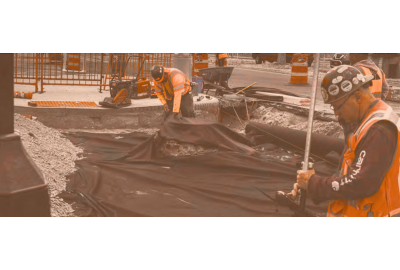When erosion control fails, the fallout is fast — blown schedules, muddy runoff, and fines that hit hard. Good erosion control isn’t about checking a box. It’s about managing water, soil, and debris right from day one.
Here’s a quick guide to the best tools for keeping your site solid and compliant.
1. Silt Fence: Manage Runoff at the Perimeter
Silt fences create a first barrier that slows stormwater and traps sediment before it moves off-site. They're critical for perimeter control on exposed soil jobs.
Field tip:
For sites with high flow or steep slopes, upgrade to wire-backed silt fences for extra strengthKey uses:
Managing sheet flow on disturbed soil
Meeting basic stormwater permit requirements
2. Inlet Protection: Stop Sediment at the Source
Storm drains are magnets for runoff and sediment. Protecting them keeps systems clean and prevents costly maintenance later.
Options that work:
Dandy Bags for flat grates
Dandy Sacks or Curb Bags where curb openings need coverage
Key uses:
Guarding storm drains during grading and paving
Keeping debris out of inlets during heavy rain
3. Slope and Bank Stabilization: Natural Barriers That Hold
Slopes are vulnerable. As soon as vegetation is cleared, they need help staying put. Natural materials like coir logs and compost socks are excellent for controlling erosion without heavy equipment.
Field tip:
Place compost socks along the toe of the slope to trap runoff without trenching
Key uses:
Protecting slopes, ditches, and streambanks
Slowing water and promoting sediment drop-out
4. Dewatering Controls: Filter Before You Discharge
When pumping water off-site, sediment control doesn't stop at the pump. Dewatering bags allow water to pass through while trapping sediment inside.
Field tip:
Always size your dewatering bag based on flow rate — oversizing can slow the job unnecessarily
Key uses:
Removing groundwater or rainwater without blowing up sediment levels
Pumping from excavations, basins, and trenches
5. Floating Barriers: Keep Waterways Protected
When construction happens near open water, turbidity curtains are the line between working clean and getting cited. They control silt in water until solids settle naturally.
Field tip:
Choose a curtain type based on flow conditions: calm water (Type 1), moving water (Type 2 or 3)Key uses:
Containing disturbed sediment near water bodies
Protecting lakes, rivers, and stormwater ponds
6. Flexible Site Controls: Move and React Fast
Not every situation needs permanent control. Sandbags and portable barriers like Erosion Eels give crews the ability to react to site changes without downtime.
Field tip:
Use Erosion Eels for drain protection when you need something quick, reusable, and heavy enough to stay put
Temporary sediment control during unexpected storms
Quick perimeter fixes while permanent systems go in
7. Stabilization Fabrics and Grids: Build Strong From the Start
Separation fabrics and grids don’t just stabilize soils — they extend the life of roads, pads, and construction entrances. Without them, base materials pump and fail fast under load.
Field tip:
Use woven geotextiles for separation under aggregate and non-woven geotextiles for drainage
Key uses:
Building stable construction entrances and laydown yards
Preventing rutting in soft soil conditions
Building Smarter Sites, One Layer at a Time
Erosion control is foundational. Plan it early. Build it right. Adjust as the site evolves.
For a full range of erosion control solutions — from silt fences to stabilization grids — we’ve got the gear ready to be delivered next-day, directly to your jobsite.





